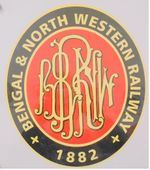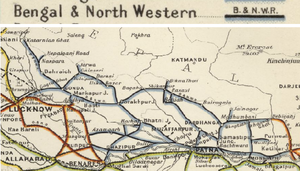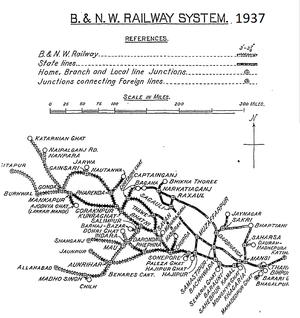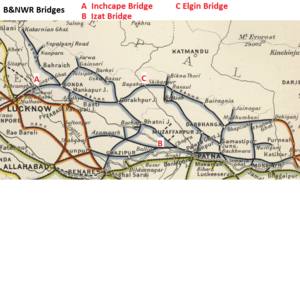Bengal and North-Western Railway
| Bengal and North-Western Railway | ||
|---|---|---|
 Bengal and North Western Railway Logo | ||
| Line of route | ||
| Gauge / mileage | ||
| Metre gauge | 902 miles (1905) | |
| Timeline | ||
| 1881 | Company formed | |
| 1884 | First section opened to traffic | |
| Key locations | ||
| Presidency | Bengal | |
| Stations | Baharaich, Basti, Bhatni, Mankapur | |
| System agency | ||
| 1881 | Bengal and North-Western Railway | |
| 1943 | Oudh and Tirhut Railway | |
| How to interpret this infobox | ||
| Bengal and North-Western Railway | ||
|---|---|---|
| [[Image:|150px| ]] | ||
| System timeline | ||
| Constituent companies / lines | ||
| Bengal and North-Western Railway | ||
| 1890 | Tirhoot State Railway | |
| Key locations | ||
| Headquarters | Gorakhpur | |
| Workshops | Gorakhpur, Samastipur (and Stores), Sonpur See B&NWR Railway Workshops | |
| Major Stations | Benares, Darbhanga, Ghazipur, Gonda, Monghyr, Muzaffarpur | |
| Successor system / organisation | ||
| 1943 | Oudh and Tirhut Railway | |
| System mileage | ||
| Metre gauge | 1468 miles (1905) 2088 miles (1943) | |
| Associated auxiliary force | ||
| Bengal and North Western Railway Battalion | ||
| How to interpret this infobox | ||
The Bengal and North-Western Railway (B&NWR) was a metre gauge(MG) railway owned and worked by the ‘Bengal and North Western Railway Company ‘(registered 23 October 1882, dissolved October 1946).
In 1890 the company took over management of the ‘Tirhoot State Railway’(TSR) and managed a number of further lines up until 1943
The ‘Bengal and North Western Railway’ was merged into the ‘Oudh and Tirhut Railway’ on 1 January 1943
Contents
History
The ‘Bengal and North Western Railway Company ‘came into being in October 1882 as a result of an agreement made with the Secretary of State for India. The government had started work in 1881 on constructing a rail link between Patna and Bahraich, along the Ghaghara River. The company agreed to complete the construction works and, in consideration of that investment, the government would provide a tranche of land without charge (instead of providing a guaranteed return). Once constructed the company became responsible for the railway’s operation under the concession agreement [1]
The B&NWR was unusual in that it was one of the very few railways promoted and constructed without Government assistance other than the gift of land, the original contract being signed in 1882.
The B&NWR Agent and Chief Engineer was Alexander Izat from February 1883, 'on loan' from the Public Works Department [2], a post which he held till the 31st May 1904 when he joined the Home Board as Managing Director [3]. An outstanding tribute was paid to Alexander Izat in 1912 - see the Inaugeration of the Izat Bridge
In 1890 the company took over management of the ‘Tirhoot State Railway’(TSR) and managed a number of further lines up until 1943 [4].
Later, following retirement of Alexander Izat in 1904, James Rennie Izat, the eldest son became the B&NWR Chief Engineer [5], and later the B&NWR Agent and General Manager, with headquarters at Gorakhpur [6]. William Rennie Izat, a younger son was the B&NWR Chief Engineer [7]. It has not been possible to determine these dates.
On 1 January 1943, the Government of India nationalised the B&NWR and amalgamated it with the Rohilkund and Kumaon Railway and the Lucknow-Bareilly State Railway to form the Oudh and Tirhut Railway which subsequently, in 1952, became part of North Eastern Railway, a zone of Indian Railways. [4]
B&NWR Lines Owned and Worked
The B&NWR system, (including the ‘Tirhoot State Railway’), eventually comprising a complicated network of lines on the left (north) bank of the Ganges between Katihar in the east and Lucknow in the west . The northernmost of which lies along the Nepal Frontier, whereit is in close touch for a length of about 400 miles. Its southern boundary is for the most part the Ganges, and includes within its area the whole of the trans-Gogra districts with most of Bihar. The lines run through an especially fertile area of land between the Ganges and Gogra rivers known as the Doab. Doab literally means land lying between two confluent rivers. Most of the trade was born by these rivers and the railway has many spur lines to ghats on both rivers
To the east it is bounded by the Eastern Bengal Railway(EBR); on the west by the Rohilkund and Kumaon Railway(R&KR);to the south by the East Indian Railway(EIR) and Oudh and Rohilkhand Railway(O&RR) broad-gauge lines Also links up with the Rajputana-Malwa Railway(RMR) metre-gauge system at Cawnpore.
In 1905 there was 1468 miles(2363km) of metre gauge(MG) in the B&NWR Network, (902 miles plus the 566 miles ‘Tirhoot State Railway(TSR)’)
By 1918 this increased to 2046 miles(3293km); (1242 miles plus 804 miles TSR)
[8]
By 1937 there was 2108 miles(3392km); (1270 miles plus 740 miles TSR)
[9]
See separate page B&NWR Lines Owned and Worked for full details of all lines
Classification
Indian Railway Classification of 1926 – Class 1 railway system [9].
B&NWR Railway Workshops
The B&NWR constructed a number of workshops over the years at Sonpur, Gorakhpur and Samastipur
See separate page B&NWR Railway Workshops
B&NWR Railway Constructions
See separate page for details
- Inchcape Bridge marked A
- Izat Bridge marked B
- Elgin Bridge marked C
Records
Refer to FIBIS Fact File #4: “Research sources for Indian Railways, 1845-1947” - available from the Fibis shop. This Fact File contains invaluable advice on 'Researching ancestors in the UK records of Indian Railways' with particular reference to the India Office Records (IOR) held at the British Library
An on-line search of the IOR records relating to this railway [10] gives 81 references. The most important being:-
- L/AG/46/23 “Records of the India Office relating to the Bengal and North Western Railway; 1882-1921”
- L /F/7/256-278 “Collection 27: Bengal and North Western Railway; 1908-1946”
Personnel Records
India Office Records. There are no staff lists or personnel records for the B&NWR held at the British Library.
Miscellaneous references have been identified from varied sources:-
- James Rhind, 1883, B&NWR Locomotive Superintendent, posted from PWD at request of Alexander Izat, on taking charge of the construction of the B&NWR. He equipped the line with rolling-stock, built a number of steamers and flats for the Ganges Ferry, Digha Ghat-Sonpur, near Bankipore, and also for the crossing of the Gogra River, near Ajoodhia'. He died in September 1888 on duty with B&NWR [11].
- George John Price, 1896, B&NWR Assistant Engineer. Employed for some years on the construction of the B&NWR Mansi-Khatihar branch line in Kharik subdivision, under Alexander Izat the Chief Engineer and Agent. Transferred to Gonda, in Oudh, where he was placed in charge of a B&NWR division of the railway and died in service November, 1903 [12].
- William Ernest Napper, 1903-20 Engineer. In charge of Gonda Division on death of George John Price in Nov 1903. Remained with B&NWR until 1920 see biography
External Links
"Bengal and North Western Railway" Wikipedia
References
- ↑ Great Britain. Law Commission, “Statute Law Repeals: Nineteenth Report : Draft Statute Law (Repeals) Bill; April 2012"; page 118, paragraph 3.14. Retrieved 19 Feb 2016
- ↑ Grace's Guide "Alexander Izat"; Retrieved on 20 Jul 2016
- ↑ India Office Records “Bengal and N.W. Ry., Opening of Izat Bridge at Allahabad, on 31st October, 1912”. Photo 1082/13(5) ; Retrieved 20 Jul 2016
- ↑ 4.0 4.1 Great Britain. Law Commission, “Statute Law Repeals: Nineteenth Report : Draft Statute Law (Repeals) Bill; April 2012"; page 118, paragraph 3.15. Retrieved 19 Feb 2016
- ↑ Grace's Guide "James Rennie Izat"; Retrieved on 21 Jul 2016
- ↑ "The London Gazette 23 March ; Retrieved on 21 Jul 2016
- ↑ Grace's Guide "W R Izat"; Retrieved on 21 Jul 2016
- ↑ "Administration Report on the Railways in India – corrected up to 31st March 1918"; Superintendent of Government Printing, Calcutta; page 157-162; Retrieved 16 Apr 2020
- ↑ 9.0 9.1 US Archive .org pdf download of ‘History Of Indian Railways, constructed and in progress’, 31 March 1937 by ‘The Government of India – Railway Department’pages 11-20, pdf 32-41; Retrieved 16 Apr 2020
- ↑ “British Library Archives and Manuscripts Catalogue” - Search"; Retrieved 20 Jan 2016
- ↑ Grace's Guide "James Rhind" Retrieved on 23 Jul 2016
- ↑ Grace's Guide "George John Price" Retrieved on 23 Jul 2016


